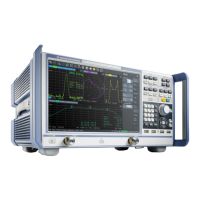Concepts and Features
R&S
®
ZNB/ZNBT
217User Manual 1173.9163.02 ─ 55
5.7.4.1 Calibration Options
In arbitrary mode, the R&S ZNB/ZNBT automatically calibrates the source and receive
frequency ranges of all ports, according to the frequency conversion settings in the
"Port Settings" dialog or in dedicated configuration dialogs.
●
SMARTerCal is the recommended calibration method for frequency conversion
measurements.
●
For measurements on non-linear DUTs, an additional scalar power calibration is
recommended; for details refer to Chapter 5.5.7, "SMARTerCal", on page 179.
●
A load match correction (optional) involves an additional reverse sweep. It can pro-
vide a significant improvement of the transmission S-parameter measurements if
the load ports are poorly matched.
Select the appropriate correction type according to your accuracy and speed require-
ments. Notice that none of the correction types provide the phase information for trans-
mission S-parameters.
5.7.4.2 Scalar Mixer Measurements
Scalar Mixer measurements are included in option R&S ZNB/ZNBT-K4.
RF mixers convert an RF signal at one frequency into a signal at another frequency.
The frequency that is to be shifted is applied at the RF input. The frequency shifting
signal (from a local oscillator, LO) is applied to the RF mixer's LO port, resulting in an
output signal at the mixer's Intermediate Frequency (IF) port. For a given RF signal, an
ideal mixer would produce only two IF outputs: one at the frequency sum of the RF and
LO (IF = RF + LO), and another at the frequency difference between the RF and LO (IF
= |RF – LO|). Filtering can be used to select one of these IF outputs and reject the
unwanted one.
Meaning of S-parameters
The frequency-converting property of the mixer (i.e. the fact that incident and transmit-
ted waves are at different frequencies) causes a loss of phase information. While a
scalar measurement is active, the reverse transmission parameter S
12
is unavailable;
the magnitude of the forward transmission parameter S
21
describes the conversion
gain. The conversion gain measurement can be improved by a source match correc-
tion (included in the SMARTerCal) and a load match correction (optional). The phase
information, including the group delay, is meaningless.
In the scalar mixer mode the analyzer provides the following functionality:
●
Configuration of the RF and LO signals and measurement of the generated IF sig-
nal.
●
System error correction and power calibration of the signal sources and of the IF
receiver. A SMARTerCal is recommended for this purpose; see Chapter 5.7.4.1,
"Calibration Options", on page 217.
●
The mixer mode can be used to test important performance parameters of RF mix-
ers such as frequency ranges, conversion loss, compression, and isolation.
Optional Extensions and Accessories

